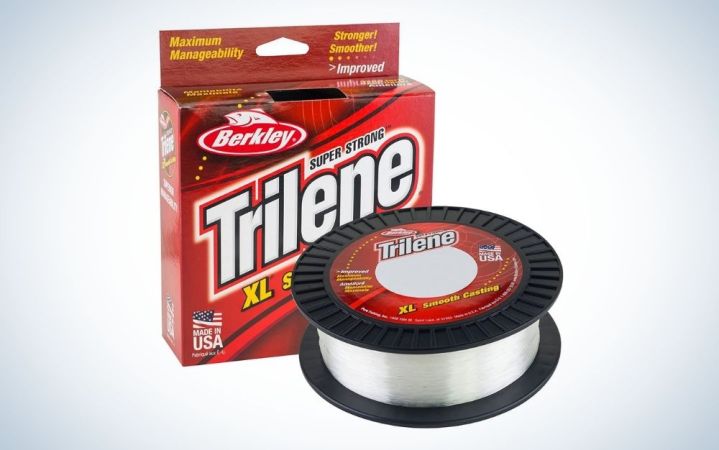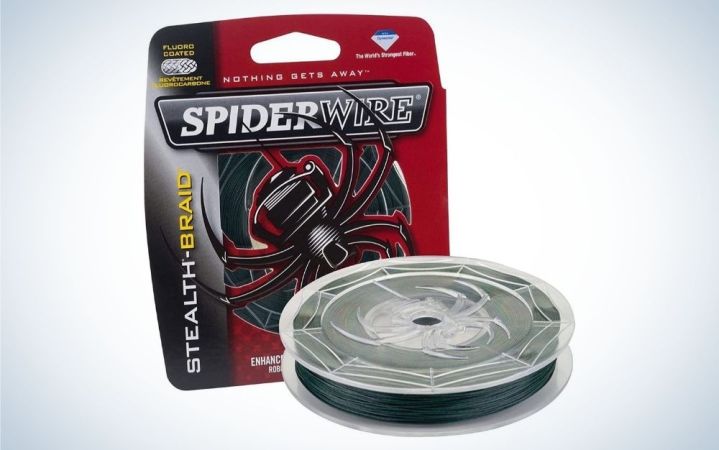We may earn revenue from the products available on this page and participate in affiliate programs. Learn More ›
Along with your rod and reel, fishing line is one of the most critical pieces of your setup. Without it, you’re taking a risk at losing a trophy fish every time your line comes tight. The rest of your fishing gear is irrelevant if your line can’t handle the job. It is important to tailor your line to the type of fishing you plan to do. Line selection depends on what you are fishing for, where you are fishing, and of course, personal preference. Understanding the factors that impact your ability to hook and land fish will serve you well when buying line. You will want the absolute best fishing line you can find so you can focus on landing a catch and not worrying about breaking off.
- Best Fishing Line for Catching Big Fish: Berkley Trilene Big Game Monofilament Fishing Line
- Best Mono Line: Berkley Trilene XL Monofilament Fishing Line
- Best Braided Fishing Line: SpiderWire Stealth Braid Fishing Line
- Best Fluorocarbon Fishing Line: Berkley Trilene 100% Fluorocarbon Fishing Line
- Best Budget Fishing Line: SAPLIZE 100% Fluorocarbon Coated Monofilament Fishing Line
Everything you need to know about fishing line
Finding the right balance in the best fishing line is often a process of trial and error. Ideally, you want a line that can handle the power and strength of the species you’re pursuing and perform well in those conditions. This might mean having an extremely abrasion-resistant line to fight tautog in rocky structures or having a very light line so you don’t spook trout in a clear river. You want to make sure all your gear is helping and not hindering your fishing.
There are several key considerations you need to make when shopping for a new line. Do you want mono, fluoro, or braid? Each type of line has positives and negatives that you need to consider. What pound test should you get? Having the appropriate pound test is crucial for catching fish and making sure you’re prepared if you hook into a lunker. What style of fishing do you plan on doing most often? Different kinds of lines will function better with different types of fishing. Picking a new line can be challenging—but thinking through your decision is important. Below is a guide to help you find the best fishing line for every scenario while on the water.
Make sure you get the correct pound test
Anytime you’re shopping for new line, you need to consider the pound test or breaking strength of the line you’re looking at. Breaking strength is a standardized rating for how strong your line is. The stronger the line you’re looking at, the thicker the diameter of the line. You typically don’t want to go too heavy with your selection as this could deter spooky fish.
What pound test should you get? The general rule of thumb is to match your line’s breaking strength to the typical weight of the fish that you plan to target. So, if you’re mostly landing 2-pound trout, get a line that’s rated to 2-pounds. Don’t worry. If you hook into something larger than 2-pounds, you should still be able to land it—so long as you have your drag set correctly.
Best Fishing Line for Catching Big Fish: Berkley Trilene Big Game Monofilament Fishing Line
Heavy Duty
Berkley Trilene Big Game Monofilament Fishing Line is high quality and heavy duty. It’s tough and shock resistant.
Mono is versatile and effective
Mono, or monofilament, is a classic choice for fishing line that functions well for anglers of all stripes. It is made out of one strand of material, which is generally nylon. It’s a simple style of line, but it’s effective for both freshwater and saltwater anglers. The best mono line can be seen in bass boats on lakes and in flats boats in intercostal back bays.
Mono is stretchy, which is typically a good thing. Mono’s stretchiness makes it shock-resistant. That’s why mono is the recommended line for trolling. Its forgiveness also helps when fighting big fish that could potentially break free without any stretch in the line. Mono is also a low visibility option, and it’s easy to handle.
Mono does have some drawbacks that you should be aware of. The stretchiness means it’s not super sensitive. You might miss some hard-to-detect strikes. It also has a slow sink rate. This makes it good for fishing topwater lures but not as good for getting your bait down deep. It tends to be thicker at any given pound test than fluorocarbon, and after prolonged sun exposure, it loses its strength.
Best Mono Fishing Line: Berkley Trilene XL Monofilament Fishing Line
All-Around Effective
The Berkley Trilene XL Monofilament Fishing Line is a solid choice for almost any angler. It’s a clear, low-visibility line that casts smoothly and is easy to manage.
Consider braid when fishing heavy cover
The best-braided line is effective for many scenarios, but it’s especially effective when fishing in heavy cover. Braid is more or less the opposite of mono. It’s made with several strands of synthetic fiber that are woven—or braided—together. Unlike mono, braid has practically zero stretches. This makes for a high sensitivity line. There is little to no lag between the time of a fish’s strike and when you’re able to sense it—and set the hook. The lack of stretchiness means you can yank fish out of cover without them being able to tangle your line around a tree root. Braid also lacks memory, which makes it easy to handle and helps prevent knots. It has a small diameter that allows you to spool more of it and make farther casts.
Be aware of some drawbacks when fishing braided lines. It is not abrasion-resistant. It is typically a high visibility line that’s not good for casting to spooky fish or for use in clear water. Try getting a braided line that matches the hue of the water you’re fishing to limit its visibility as much as possible, or use a monofilament or fluorocarbon leader.
Best Braided Fishing Line: SpiderWire Stealth Braid Fishing Line
Camo Power
SpiderWire Stealth Braided Line comes in an array of color options that camouflage the otherwise high-vis line in many types of water. The line is strong and casts well. It’s a sensitive line that helps make you feel even the slightest bite.
Fluorocarbon line is another great option
Fluorocarbon has become a popular style of fishing line among anglers in recent years. Once limited to being used as durable leader material, many anglers now use it as their go-to fishing line. Why? Fluorocarbon is a low-visibility line that’s also abrasion-resistant, sensitive, and tough. It is the best line for trout due to its low-visibility in the water. It is common to see fly anglers have both fluoro leader and tippet on the river.
Fluorocarbon line does have some downsides. For one, it has a lot of memory, which means it holds curls and bends more than braid or mono. This makes it one of the least manageable types of fishing lines. Fluorocarbon is also not as shock-resistant as mono. It sinks quickly, so it’s not a great topwater line, though it is good for getting your lure down in the water column.
Best Fluorocarbon Fishing Line: Berkley Trilene 100% Fluorocarbon Fishing Line
Versatile and Low Visibility
Berkley Trilene 100% Fluorocarbon is an excellent option for anglers that want a top-quality fluorocarbon option that’s still relatively manageable. The line is very low-visibility and abrasion-resistant.
What to know about budget fishing line
The best fishing line can get expensive, especially when you’re spooling hundreds of yards of it on your reel. Spending an extra couple of bucks on a premium quality line is generally a good idea. You’ll be sorry if a fish of a lifetime breaks your line because you were too cheap at the tackle shop.
That said, it is possible to save a couple of bucks on line without throwing your chances of catching a big fish away. Brand name fishing line is generally more expensive than some lesser-known alternatives. If you’re looking for an affordable line, search for a product from companies that aren’t as well known. The product should still be made out of high-quality material and match the style of fishing you’re hoping to do.
Best Budget Fishing Line: SAPLIZE 100% Fluorocarbon Coated Monofilament Fishing Line
Cheap but Strong
SAPLIZE 100% Fluorocarbon Coated Monofilament Fishing Line is a high-quality option at a very competitive price point. The line casts well. It is a lightweight and low visibility.
FAQs
The best kind of line depends on the style of fishing you do. Mono is the most versatile option and is likely the best choice for trolling. Fluorocarbon is similar to mono. It’s abrasion-resistant and invisible but can be difficult to handle. Braid is sensitive and strong but not stretchy. It is the best for fishing heavy cover.
Most fishing lines are clear and are usually the best option for fishing clear water. Braid is the only kind of line that is not clear. Try to match the color of your braid to the hue of the water you fish most often.
It depends on how often you use it, how much sun exposure it receives, and how much wear and tear it gets. A good rule of thumb is to replace your line at least once or twice a year. But if you see abrasion or weak points in the line, then you should replace it immediately.
The final word on finding the best fishing line
The best fishing line is the backbone of any fishing setup. You need to be able to trust your line when you’re on the water. Make sure you buy line that is right for the fish you’re after and the tackle that you’re using.





